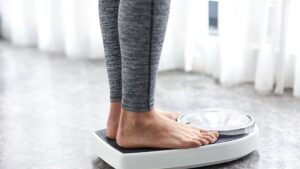Eating well and exercising routinely are essential for achieving success in all spheres of life.
For the hip size to increase and the hips to get wider, targeted exercise is necessary. Despite the fact that there are steps that can be taken to enhance the appearance of the exterior areas of hips and thighs, regardless of how much effort is put into them, the bone structure they are born with is immutable.
Even if you’re slender or you have a family history of having overweight bodies, you can still definitely tone your hip and belly muscles in a way that accentuates them.
You can increase the size of your hips by performing hip-specific exercises and consuming a protein-rich diet that promotes muscle growth.
What Causes Fat Hips?
When you eat more calories than you burn off or when you don’t move as much as you should, fat cells grow in the body.
Such fat cells have a tendency to cluster in specific areas over time, such as the hips and waistline, where they’re most noticeable.
Fat accumulation can occur on any part of the body, however, the lower back, hips and abdomen are particularly prone to fat accumulation if a number of risk factors are present.
Which Muscles Should You Focus On To Have Broader Hips
Hip muscle development is the most effective method of gaining weight in the hips, as the primary activity of the human body is the formation of muscles. The gluteus minimus is connected to the gluteus maximus by a postural lumbar lumbar artery. This is why it is important to build hip muscles to improve hip flexion.
Must Read : Benefits of the amazing wall sit workout.
Workouts for the Hips
There are many muscle-building workouts that can aid in your goal of gaining weight in the hips.
Limb maximus is the best exercise to work on the upper back. It involves different types of squats, deadlift, and hip isolations.
- Begin with Squats
The fact that squats facilitate your body’s ability to perform vital actions like both standing and sitting makes them an excellent hip-building workout. Also, they are excellent in enhancing hip strength.
- Deep Squat
Going as low as possible without bending your upper back is the objective of this dumbbell exercise.
You must bend your knees more than usual to perform a deep squat, keeping your weight equally distributed between your feet with the help of your hips, your left leg and your right leg. Maintaining a neutral spine position is also important while lifting weights.
Squatting is a great exercise for developing overall muscle strength in addition to enhancing leg and glute muscle power, because the most difficult part of a squat or deadlift is the bottom.
- Squats in the sumo style
The sumo squat is a variation on the normal squat that concentrates on the gluteal muscles. The toe should be positioned at a 45° angle and the foot must be kept in a wide position. The alignment of the shins to the rest of the body is done by squatting and pressing down on one of the heels.
- Split squats in Bulgarian style
Bulgarian split squats not only develop your glutes and quadriceps but also your hamstrings. Find a bench or stair that’s approximately at the height of your knee level to do it on. Next, take a forward lunge posture by keeping your abs firm, keeping your body upright, and placing one foot upon that bench at the back of you.
Bend your torso down and bring your front leg to the horizontal. Always keep your knees and feet in the correct alignment. Pull up your right leg next, and then drive up with your left leg to get back to the starting position.
Include Lunges
Another traditional exercise that will help you develop larger hips is the lunge, which targets the legs and buttocks. To maintain balance and stability, hip muscle is essential.
- The Curtsy Lunges
The curtsy lunge is a great exercise for the quadriceps and glutes. You must first bring yourself to a standing position and slightly straighten your shoulders. Leaning forward on your right leg, you can swiftly press your thigh towards the floor. Once you’ve discovered a comfortable position, you can lift your leg slowly to return it to its starting position. Before changing sides, take 10 steps in each direction before changing sides.
- Lunges to the side
Side lunges could even help you shape your hips by building and strengthening your abductors and forcing you to swiftly speed up and slow down your hip movements.
Position yourself in the starting position by keeping your feet together and standing upright. To perform a bent knee side step, one should lead with their right foot and step out with their left foot. Make sure your bowed knee is exactly over the second toe by gently turning your foot and leg outward.
Maintain a straight spine and tight abs as you proceed to lean at your right leg and pull your hips backward. Your spine will bend slightly forward at this point.
As you perform the aforementioned actions, keep your gaze forward and remember to exhale.
Raise the body back to a standing posture by pushing off with your right leg.
Include hip abductions
The thigh being angled away from the center of the torso is referred to as hip abduction. It’s what we do whenever we take a step sideways, get up from bed, or get out of a car.
Hip abductors are often overlooked, but they play a huge role in our overall posture, walking style, and how we rotate our legs. If you’re looking to get wider hips, hip abduction is a great exercise for you.
- The Hip drops
Stand on your right foot and put your foot flat on the floor, on a step, or anywhere else that’s elevated. Lift your hips and then put your left foot down.
Throughout the complete motion, it’s essential to keep your shoulder blades downward and maintain a straight standing leg. While bending over, stop your hips from moving for about three seconds.
Put your hips flat on the floor and return to your neutral position. Slowly lower and lift with precision and stability. This workout program should be performed as frequently as possible, however, we suggest performing 20 to 25 repetitions on either side of the body.
- Sidewalks with Stretching or Resistance Bands
If you want to get big hips, you can move laterally while doing resistance exercises. But if you have really weak hip muscles, it’s important to build them naturally with stretching bands.
Position yourself in the starting position and secure the band around the ankles, but not encircling the bone. Place your feet just below the hips and squat down to a point where you are almost in a sitting posture.
Lower your shoulders and look ahead, maintaining a neutral stance. Take a slight side step and apply pressure to the resistance band with your heel.
Step together to bring your ankles back into hip-width alignment.
Set your bodyweight on the hips to move forward while paying focus to keep your ankles parallel.
Diet for wider hips
Exercise is a key factor in achieving wider hips and weight loss, however, a healthy diet is also important. The following diet recommendations will help you to achieve wider hips as well as butt muscles.
- Legumes
Legumes are a healthy dietary option in addition to being highly rich in protein, dietary fiber (complex carbohydrates), and other nutrients, which helps you maintain a steady amount of energy.
Eat a range of beans and lentils, including peas, red, green, and black beans, kidney beans, whole lentils as well as yellow, red, and green lentils.
- Calories
Achieving a healthy caloric intake can contribute to weight increase and butt enlargement. Therefore, it is important to be aware of your overall calorie intake in order to maintain a healthy weight.
- Brown Rice (Whole Grain)
The cereal is a rich source of dietary fiber. White rice is acceptable If you serve it alongside lots of vegetables. But if you consider the fiber they include, brown rice is much more nutritious. This significantly aids in maintaining energy levels while working out the butts.
Lifestyle
Whether or not you want bigger hips, maintaining a healthful lifestyle is beneficial. Therefore, make sure to integrate regular workout into your daily routine and keep in mind the workout and a healthy intake of calories always go hand in hand.
Conclusion
You can also shed some of the extra fat that’s been building up on your muscles. Plus, getting enough sleep helps your body heal itself and make new cells. So if you’re looking for bigger hips, it’s all about finding the right balance.
Remember that if you want to build more muscle in the zone surrounding your hips, you will need to work diligently and be dedicated to a routine. It necessitates dedication and effort. Therefore, it is essential to identify a weight training regimen and dietary regimen that is effortless to adhere to.









